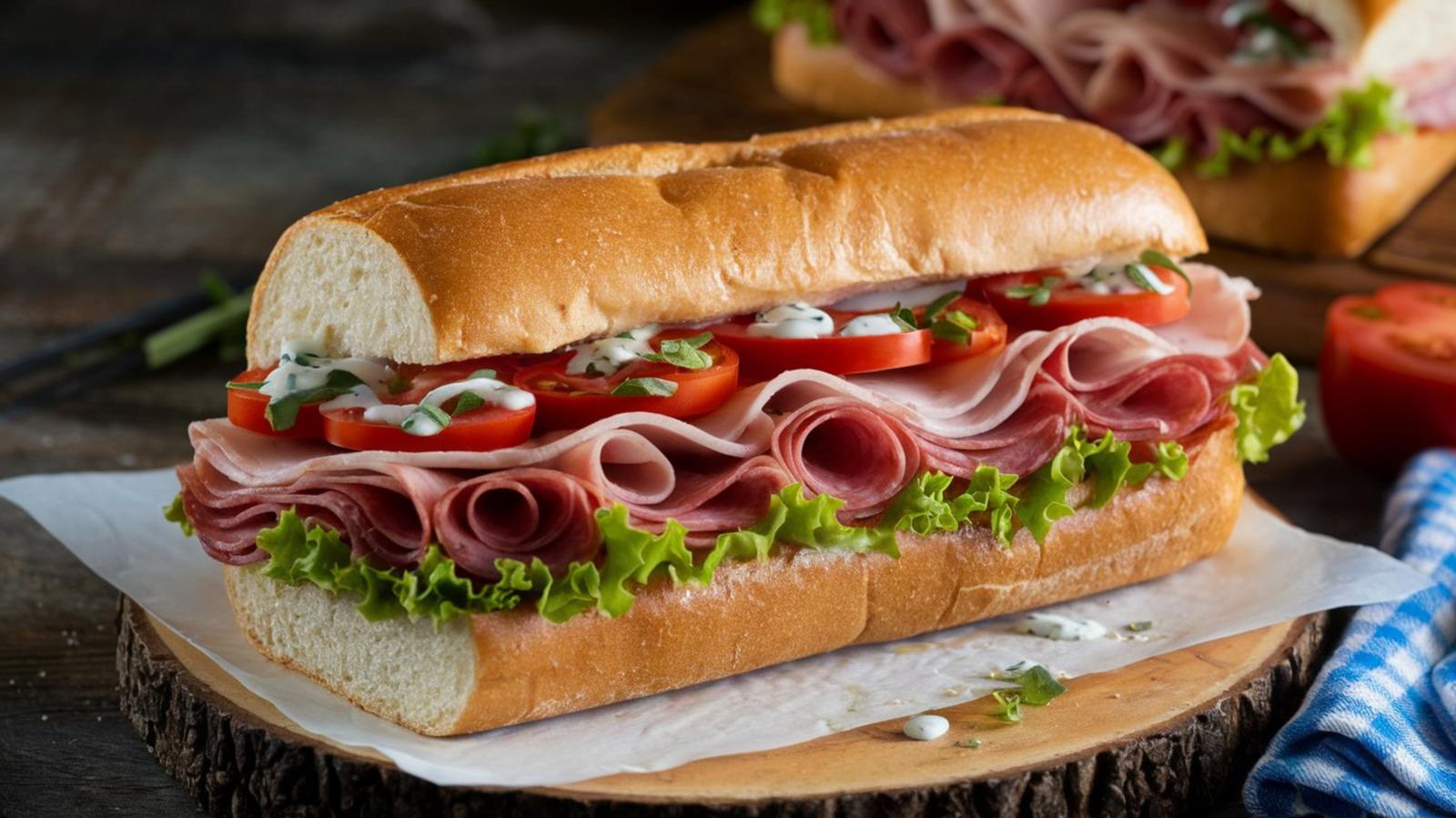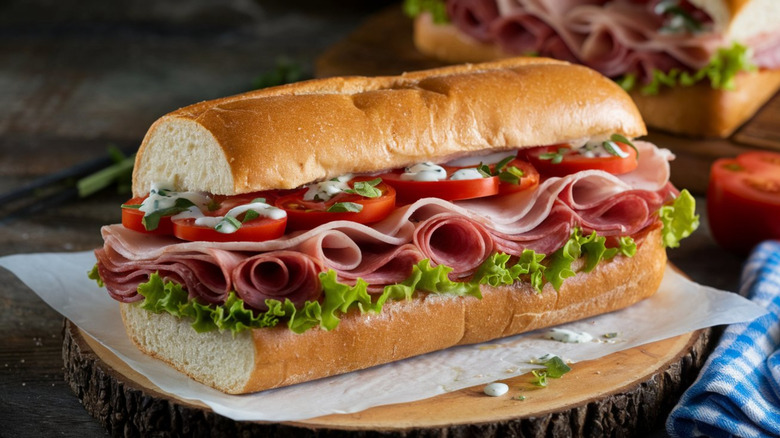
Lanista/Shutterstock
People have been eating dishes that combine meat, cheese, and vegetables for thousands of years, but the beloved Italian sub only dates back to 1899. The inventor of the Italian sub was a man from Portland, Maine, named Giovanni Amato. He whipped up these sandwiches to help construction workers stay energized all day. In a little over 125 years, the Italian sub has become a staple in every sandwich shop throughout America.
The sub itself is humble, with only a handful of ingredients. However, plenty of home cooks are left scratching their heads after they try to make one at home and realize it doesn't taste as good as the ones they order at sub shops. As it turns out, there's a lot of magic that goes into the assembly process. Not only does the quality of the ingredients matter, but you also have to pay attention to the order of your ingredients and how you place them on the bread.
How can you start making better Italian subs at home? Read on to explore the top mistakes that can ruin an Italian sub so you'll know what to avoid.
Choosing the wrong type of bread
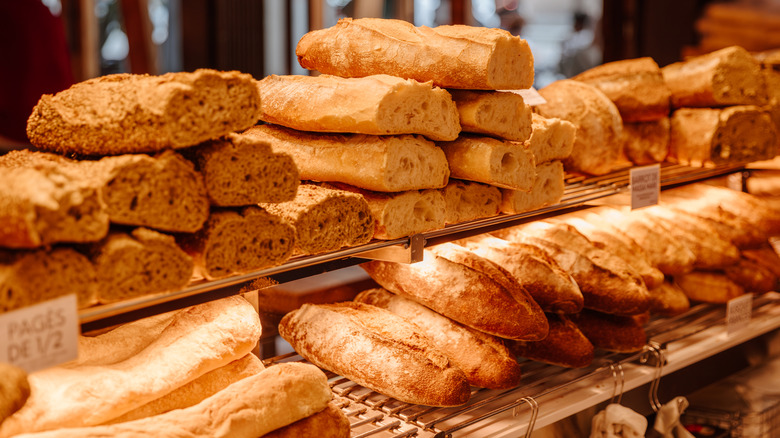
Alexander Spatari/Getty Images
Meats and cheeses do a lot of heavy lifting in a sandwich, but no one can deny that the bread can make or break the entire experience. Without a sturdy yet airy base, the sandwich falls apart.
Sticking with the pre-packaged sub rolls filled with preservatives can allow you to make a decent sandwich, but it will never compare to a sandwich shop that bakes its own loaves fresh daily or gets them delivered from a bakery. This is why the first thing you need to do when you have a hankering for an Italian sub is visit a local bakery or, at the very least, go to the bakery section of the grocery store rather than the packaged bread aisle.
With so many types of loaves to choose from, how can you know you're making the right decision? Personal taste should factor into the equation. Some people prefer sesame bread, a hearty whole-wheat loaf, pillowy bread, or something more rustic. Once you consider those details, you need to ensure that your loaf is wide and long enough to handle lots of fixings.
You can never go wrong with a classic sub roll. Some other options you might want to experiment with include baguettes and Cuban bread. Try to avoid loaves that are too tough or crunchy because you don't want to give your jaw a workout.
Forgetting to add a protective fatty layer on your bread
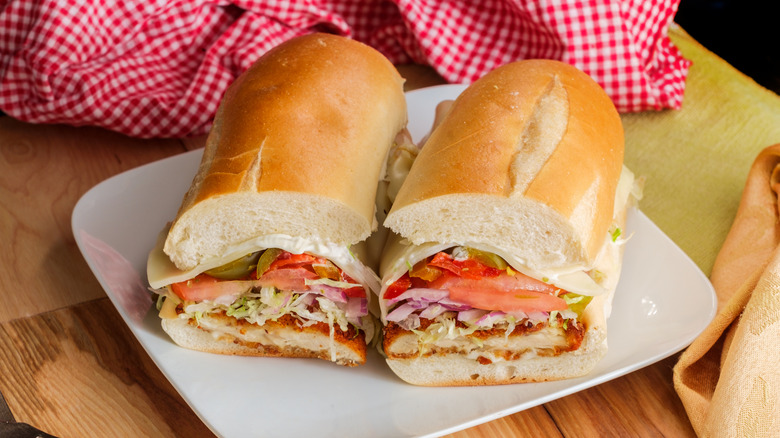
Ezume Images/Shutterstock
Biting into unexpectedly soggy bread is one of the most off-putting dining experiences. Even though Italian subs have a lot of juicy ingredients, you can build your sandwiches in a way that protects the structural integrity of the bread. The secret is creating a protective fatty layer that blocks moisture.
Most sandwich shops accomplish this by brushing some olive oil onto both halves of the sub roll. For extra richness, melted butter could do the job as well. Of course, you can never go wrong with classic mayo.
If you're wondering why this works, think back to any time you've ever tried mixing water with oil. Some salad dressings may have distinct layers until you shake them because the oil has separated from the water. On a molecular level, oil is hydrophobic, which means that it will always repel water molecules that get near it. As a result, building a foundation with any type of fatty spread on your Italian sub will help prevent leaks. This quick step makes all the difference for the texture of your sub, so never skip it.
Failing to create a balance of lean and fatty deli meats
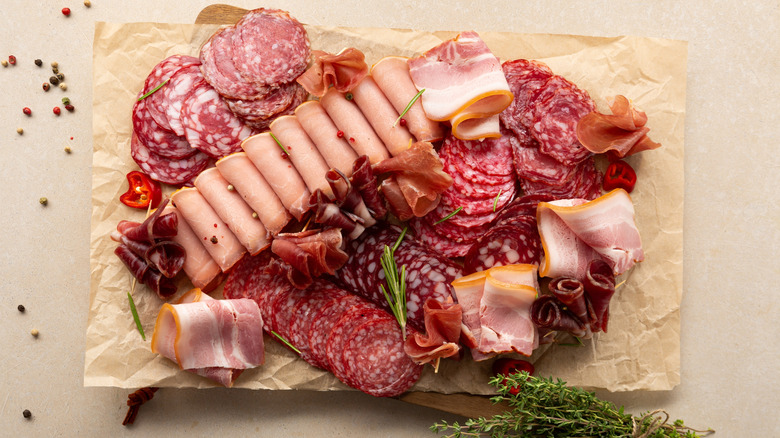
Afanasieva/Shutterstock
There are some folks out there who may argue that you can never have too many fatty meats, but the average person's palate will appreciate some nuance. Incorporating lean deli meats into your sub lineup will allow you to create more volume without going overboard on the richness. You might have to play around with your ratio until you discover what you love best, but it's wise to start with a 2-to-1 ratio of fatty and lean deli meats.
For lean meats, you can't go wrong with ham and prosciutto. There are all kinds of varieties of ham at your local deli, so spend some time sampling different herbs and glazes. For fatty meats, keep your eyes peeled for salami, mortadella, soppressata, capicola, and even pepperoni. These unctuous cuts will pack tons of flavor and a divine texture into each bite.
For a truly gourmet experience, you shouldn't opt for the cheapest cold cuts you can find. You don't need to break the bank by choosing fancy imported meats, but you should also steer clear of low-quality meats from brands like Oscar Mayer. Familiarize yourself with reliable deli meat brands that use great ingredients before you go shopping so you can have the yummiest Italian sub possible.
Not thinly slicing your veggies
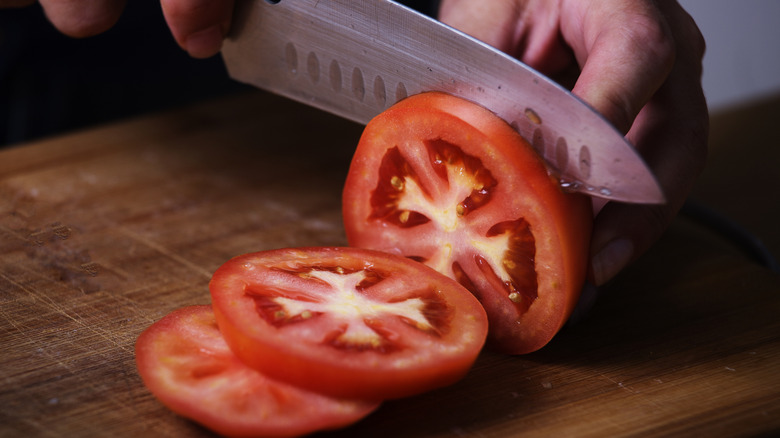
Brazzo/Getty Images
The tastiest Italian subs have an impressive range of ingredients that work together to amplify the flavors of the meats and cheeses. Veggies play a huge role in adding some much-needed moisture so you don't feel like you're about to choke every time you take a bite. However, it would be a tragedy to sink your teeth into a sub and get overwhelmed by a beefy slice of tomato.
This is why you have to practice your knife skills so you can safely create thin, even slices for your vegetables. Tomatoes tend to be the most intimidating sandwich vegetable because of the high water content, but a sharp knife and some patience will go a long way. You'll also need to chiffonade some iceberg lettuce. You may be tempted to grab some bagged lettuce that's already shredded, but the taste won't be as fresh.
No Italian sub would be complete without some red onion. Thinly slice one and carefully separate the rings so you can layer them on your sub and create good coverage without overpowering the other ingredients.
Not folding your deli meats to create more volume
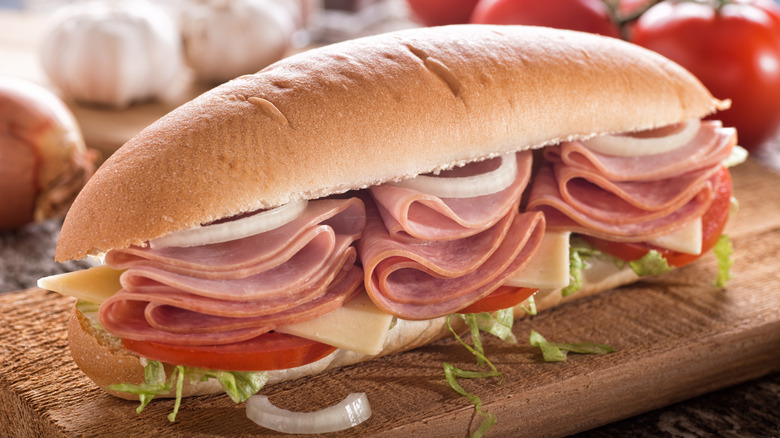
Fudio/Getty Images
Why do sub shops always seem to make better sandwiches than the ones people whip up at home? Some argue that food simply tastes better when someone else prepares it. While there's definitely some truth to that, another secret that many home cooks aren't aware of is that you need to fold your deli meats strategically.
You should never take the meat straight out of the package and place it on your sub roll. That's the quickest way to create a dense sandwich that lacks flavor. Instead, try loosely folding each slice in half, then tucking the bottom so it meets the center, and the upper half is still out. The goal is to create folds with lots of air in them.
Why does this matter? When it's time to season your Italian sub with vinegar, oil, and herbs, you're creating more cavities for flavor to cling to. Each bite can also seem airier, which elevates the whole sub.
Spreading your ingredients out too much across the sub roll

Marko Jan/Getty Images
Have you ever bitten into a sandwich and realized that tons of ingredients were missing or barely there? Sure, a high-quality loaf of bread is tasty enough to bite into plain, but no one would be happy if they were expecting to taste a sandwich bursting with different ingredients. This is why you need to strike that perfect balance of loading up your Italian sub without making it too thick to fit into your mouth.
Italian sub experts say that a good rule of thumb is to have a little bit of overlap when you're piling on the meats and cheeses. This will give you some wiggle room in case things somehow shift a bit while you're adding other toppings or picking the sub up to eat.
Make sure each type of meat and cheese extends to the edge of your sub roll as well. You may want to construct the sub at a slight angle or slice your cheese in half to get the most out of the length of each piece.
Forgetting to make a vinegar and oil dressing
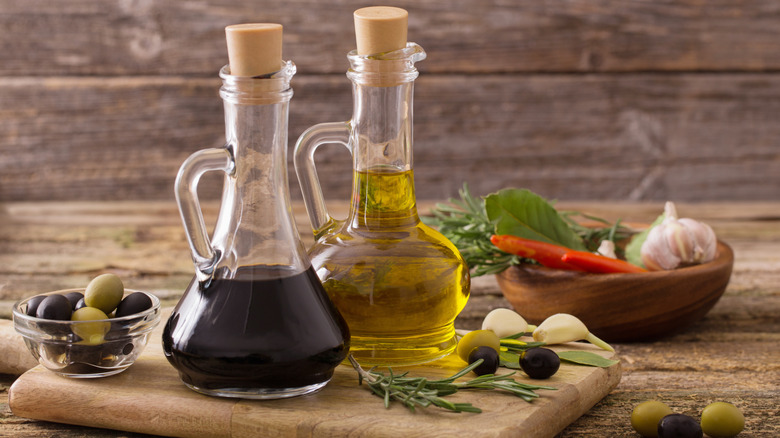
Maya23k/Getty Images
Would you ever want to eat a salad without any dressing? If not, why would you ever put salad ingredients on a sandwich without dressing either? Every good sub shop knows that the humble yet reliable vinegar and oil dressing is always a crowd pleaser.
What usually goes on an Italian sub is a dressing that combines red wine vinegar, olive oil, oregano, salt, and pepper. However, nothing is stopping you from getting even fancier if you want. You could love the addition of some honey, red pepper flakes, or Dijon mustard.
In fact, the experts at "America's Test Kitchen" love adding a squirt of mustard into the mix because it helps with emulsification. You won't have to worry about some bites tasting too oily while others are too acidic because the oil and vinegar are separated. You'll also have an easier time spreading this dressing onto your sub roll and coating your greens evenly.
Assembling your sub in the wrong order
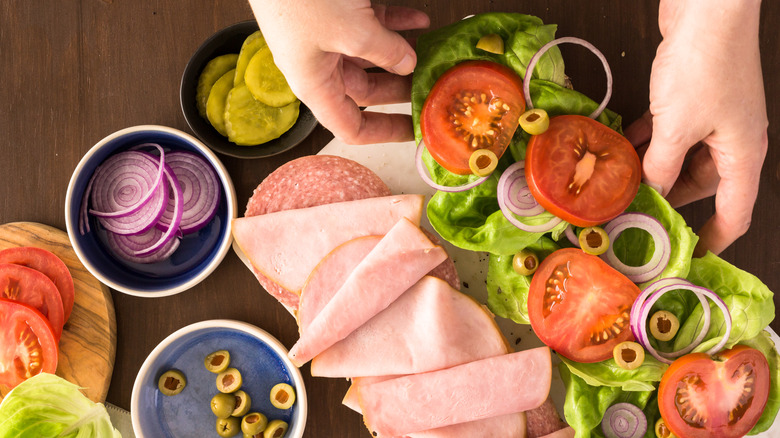
Arinahabich/Getty Images
Sub experts assemble sandwiches in slightly different ways, but they all agree that mayonnaise, olive oil, butter, or another fatty spread needs to be the foundation. Afterward, they either pile on the meats or cheeses.
One benefit of starting with cheese is that you could pop your sub into the oven for a minute to melt it a little if that's your preference. Another benefit is that your cheese layer will be thinner than all the folded meats, which could keep your sub more neatly stacked. However, the choice is yours.
Now, it's time to think about your veggies. The standard order of assembly is lettuce, dressing, tomato, onion, and any other veggies you like. The logic is to create a thick, sturdy bed of lettuce and build upon it in a way that goes from largest to smallest slices of vegetables. Tomatoes are the biggest, and then slices of onions are smaller. Vegetables like banana peppers and pickle chips are even smaller, which means they won't slip out of place if they're on top.
If you've been a victim of soggy tomatoes causing your entire sub to slide apart, the only difference you may want to consider is saving your tomatoes for last. What you could do is build your sandwich up, add a fatty layer to the top half of your sub roll, then place the tomato slices directly on top to glue them in place.
Choosing the wrong greens and failing to season them
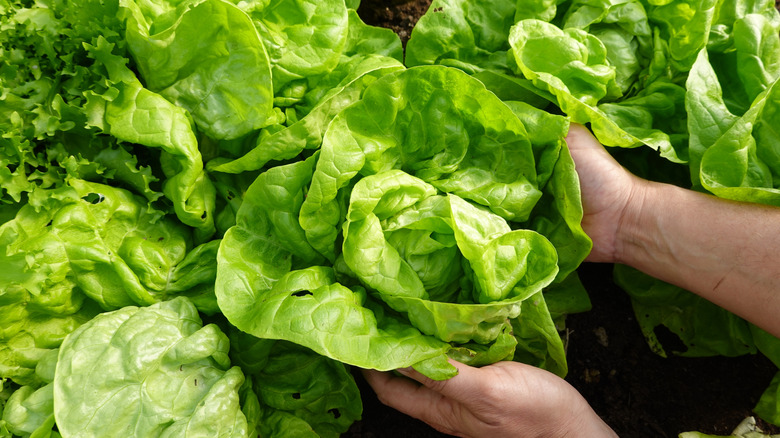
La Huertina De Toni/Shutterstock
People could spend many hours debating which kinds of greens belong on an Italian sub. Some of the most common types of lettuce you'll find on sandwiches nowadays include romaine, iceberg, butterhead, and little gem. You also have to factor in other leafy greens, such as arugula, cabbage, spinach, and kale.
Everyone's allowed to have their own preferences based on taste, texture, and wellness goals. However, iceberg reigns supreme when it comes to crunchiness and being a blank canvas that can soak up other flavors well. Iceberg lettuce is also easy to chiffonade. This technique will help you with your mission to create volume in your sandwich since each handful will fluff up.
Don't forget to dress your iceberg. Whether you stick with the classic vinegar and oil dressing or spice things up, one brilliant tip is to toss your greens and dressing in a bowl before you add them to the sandwich, rather than pouring the dressing on top. Plenty of sub shops skip this step because they're experts at pouring. If you also decide to skip it, you need to make sure you're careful when you're adding the dressing on top so you don't end up with any dry or overly-seasoned spots.
Using a low-quality cheese
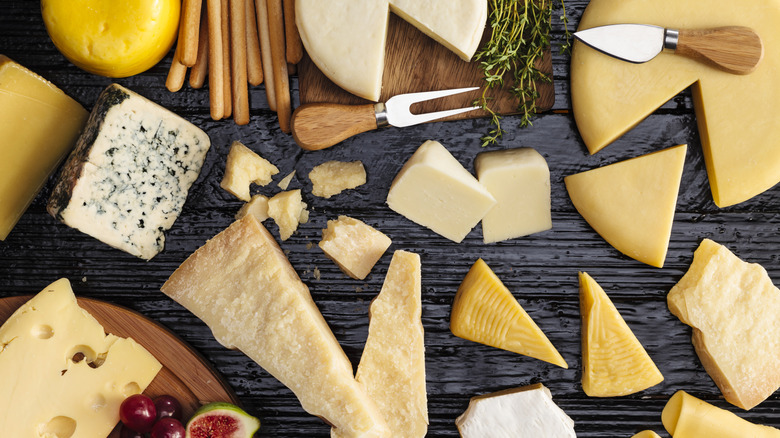
Fcafotodigital/Getty Images
The last thing you want to do is rip open some Kraft Singles and put those on your Italian sub. That's the quickest way to give your sub an overly-processed flavor. Most sub shops choose provolone for Italian subs. It's creamy, and it has a perfect velvety texture when it's heated.
What some home cooks may not know is that provolone develops more flavor as it ages. Keep your eyes peeled for aged provolone the next time you grocery shop. It has enough body to stand up to fatty meats that typically go in an Italian sub, such as soppressata. It's worth trying Italian subs that have provolone, aged provolone, and even a combination of the two.
Another high-quality Italian cheese that you may want to include in your next sub is fresh mozzarella. It won't add much flavor, but it can create more creaminess if that's a texture you love in your subs. If you feel overwhelmed when you're browsing the deli and dairy sections of the grocery store, this expert-curated guide on Italian cheeses can help you make smarter purchases.
Stopping at lettuce, tomato, and red onion for toppings
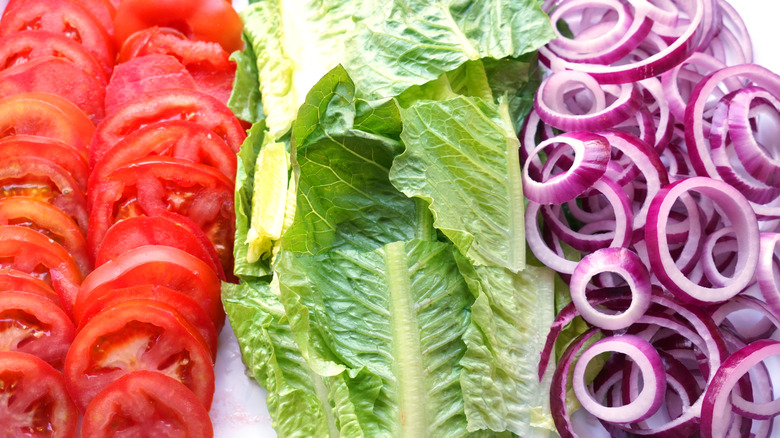
Xphotoz/Getty Images
Underestimating the power of vegetables is one of the biggest mistakes everyone makes with sandwiches. If you stopped assembling after the meat and cheese, your Italian sub would be terribly dry and lacking in some crucial flavors. Lettuce adds crunch and is the perfect vehicle for your oil and vinegar dressing. Tomatoes bring juiciness, and red onions are delightfully zippy. While these toppings are essential, you're doing yourself a disservice if you don't add a few more veggies into the mix.
Italian subs benefit from some tang to cut through the richness of the meat and cheese spread. Dill pickle chips, sliced banana peppers, and even pickled jalapeño slices can take your Italian sub to new heights. These toppings are traditional, but feel free to add other veggies you enjoy. Olives, cucumbers, and even sliced bell peppers could be great.
One secret ingredient that should be in every sandwich lover's fridge is Cento's Hoagie Spread. It contains pickled cherry peppers that have been finely chopped. The end result is a texture that's easy to spread evenly on your sub so you don't get unappealing, big chunks. The pickling process introduces the vital vinegary taste, and the peppers have a subtle heat. It could be the ingredient you've been desperately searching for on your quest to recreate sub shop sandwiches at home.
Overlooking a seasoned mayonnaise spread
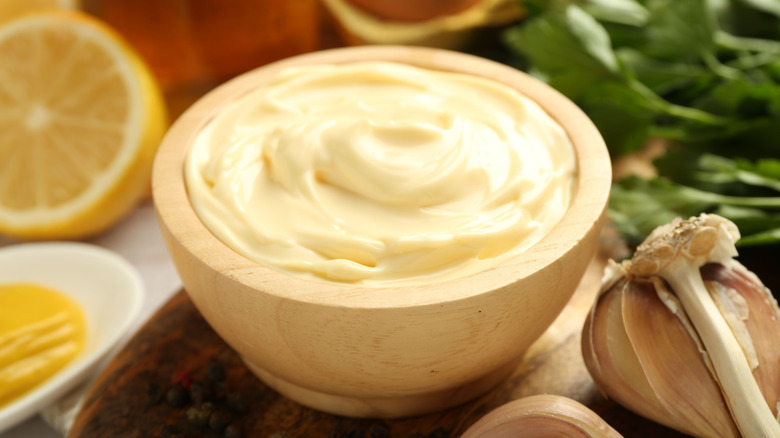
Olga Yastremska/Getty Images
Some purists believe that olive oil is the only type of fat that belongs on an Italian sub. However, there are plenty of reasons why mayonnaise has become a staple in all types of sandwiches. Not only does it provide that fatty barrier that protects bread from wetness, but it also has a luxurious texture, and it carries other flavors beautifully. You're missing out if you don't experiment with mayo.
One tried-and-true seasoned mayonnaise recipe combines mayo with one clove of grated garlic, a squeeze of lemon juice, and a small handful of chopped basil leaves. The garlic gives the mayo a special kick, the lemon juice brings some acidity, and the basil leaves add some classic, fresh Italian flavor. It's perfect for an Italian sub and other types of sandwiches.
If you love the taste of pickled peppers on your Italian sub but don't appreciate getting big bites of them, you could even toss a few of them into a blender with your mayonnaise to get the best of both worlds.
Failing to consider wrapping your Italian sub
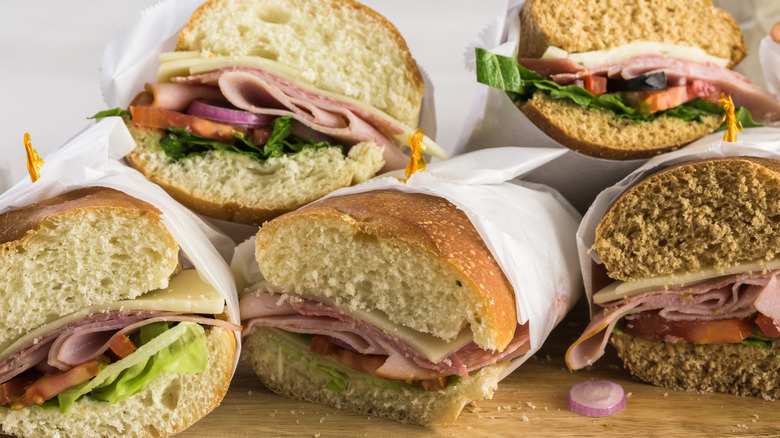
Arina P Habich/Shutterstock
As silly as it seems sometimes, we must embrace the fact that we eat with our eyes first. If you always love ordering subs at a shop, it's worth noting that your brain is used to receiving these sandwiches wrapped up. Part of the experience of eating a high-quality sub is unwrapping it like a gift. This is why it could be worth buying a roll of butcher, wax, or parchment paper for your subs. Wrapping it may seem like a disaster waiting to happen, but you can become a pro in no time.
The basic technique is to tear off a large square and situate it on the table so it's like a diamond. Set your sub down in the center, grab the bottom of the paper, and wrap it all the way around the sub until it meets the middle of the paper. Next, grab your ends and fold them into the sub. Finally, grab the entire sub and roll it until everything is neatly wrapped up.
Some people prefer slicing their subs through the paper so they can eat each half with the wrapper still on. Others cut their sandwiches before wrapping them and then remove the paper once they're ready to eat.
Digging into your Italian sub too soon
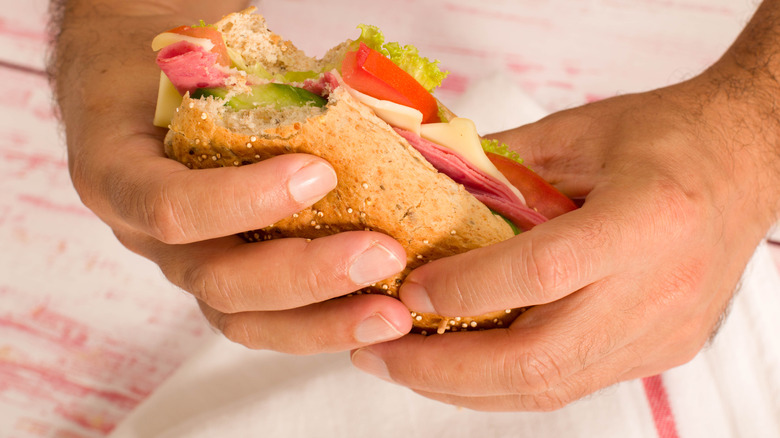
Anaimd/Getty Images
Now you understand that a lot of thought goes into crafting the perfect Italian sub. You may have built up quite the appetite by carefully assembling it. As tempting as it may be to just shove that sub into your mouth, it does pay off to let your fully assembled sub rest for a few minutes. This is especially true if you've wrapped it snugly, which locks in those flavors.
Just like meat tastes better when it can marinate overnight, magic happens when the ingredients in a sub have the chance to mingle. The fatty ingredients can help blend the flavors of the meats, cheeses, and vegetables. Acidic vegetables and your oil and vinegar dressing can seep into all of the layers.
The good news is that you don't need to wait 12 hours like you would for a meat marinade, since everything would be soggy at that point. In only 10 or 15 minutes, your sandwich can have that extra oomph factor that will blow your taste buds away.



